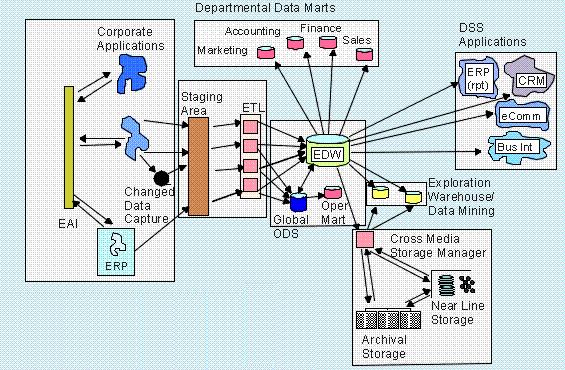Summary: in this article, we will discuss Bill Inmon’s data warehouse architecture known as Corporate Information Factory.
Introduction to Bill Inmon data warehouse architecture
Let’s start with Inmon’s data warehouse architecture picture below. We will examine each element in Inmon’s data warehouse architecture and how they work together.
To understand Inmon’s data architecture, you can look at the picture from left to right. There are some elements as follows:

- Corporate Applications: These applications are operational systems or transaction systems that develop to support business. Transaction systems collect data from business transactions such as sales, marketing, material management and stored those data in various forms, including relational data, hierarchical data, or even spreadsheets. In Inmon’s architecture, transaction systems are also called source systems that provide data to the data warehouse.
- ETL Processes. To bring data from the transaction system, a process called ETL is used. ETL stands for extract, transform and load. ETL process consolidates data, transforms it into a specific standard format, and loads it into a single repository called an enterprise data warehouse or EDW. ETL processes can run as a batch process periodically or a transaction-based for near real-time data. The ETL process is referred to as data integration or data services.
- Enterprise data warehouse is a central element in Inmon’s data warehouse architecture. As Inmon’s data warehouse definition, an enterprise data warehouse is an integrated repository of atomic data. Data in the enterprise data warehouse is captured at the very lowest level of detail. Data in the enterprise data warehouse is stored in a relational database and uses a third normal database design.
- Data marts are departmental views of information with subject-oriented data. Data marts take data from the enterprise data warehouses. Aggregations can take place when data brings from the enterprise data warehouses to data marts. Data marts use dimensional design. Therefore, the data in the data marts is ready for analysis. It is important to note that all the external applications or reporting tools or business intelligence tools query data marts instead of enterprise data warehouses.
Inmon’s data warehouse or corporate information factory is also known as the atomic data warehouse.
In this article, we’ve introduced Bill Inmon’s data warehouse architecture called corporate information factory. In Bill Inmon data warehouse architecture, data is organized using ER modeling. Enterprise data warehouse is the hub that provides data for data marts. Analytic systems query data against data marts not directly from the enterprise data warehouse.